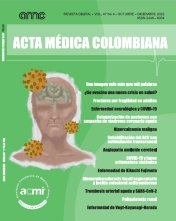A description of the risk factors related to fragility fractures in adults and their associated costs
Abstract
Objective: to identify bone fragility risk factors associated with increased total fracture care costs at a clinic in Medellín, Colombia.
Design: an observational study with retrospective and prospective measurements taken from the medical charts of patients admitted for fractures and followed until discharge. Frame of reference: Hospital Alma Mater de Antioquia, Medellín, Colombia.
Participants: four hundred fifty-two patients diagnosed with fragility fractures on admission.
Main measurements: the prevalence of bone fragility risk factors, a description of the total care cost by risk factor and an estimate of the association between the risk factors and total costs.
Results: Diabetes (24.3%) and active or passive smoking (21%) were the most prevalent fragility risk factors. Hip fractures were the most frequent and costly (36%, Md: COP 7,882,579). Fracture care was more costly for active or passive smokers (Md: COP 7,484,185), and those 75 years old or older (Md: COP 7,057,678). According to the significant adjusted estimates (p<0.05), the median cost for active or passive smokers exceeds that of nonsmokers by more than COP 2,300,000, and every year of age increases the median cost by more than COP 90,000.
Conclusions: this study emphasized that bone fragility is a public health problem. Factors like active or passive smoking and age were found to increase fragility fracture care costs, implying more complications and need for services. This adds to the evidence for strengthening monitoring programs to reduce the morbidity, mortality and direct costs of this disease in Colombia
Metrics
Copyright (c) 2022 JANETH LEAL BELLO, Alejandra Rendón , Diana Anguita, Kely Rodriguez, Diego Pinto , Henry Quevedo, Daniel Jaramillo

This work is licensed under a Creative Commons Attribution 4.0 International License.
Acta Medica Colombiana uses the CC-BY 4.0 license. Authors retain all rights over their work.


